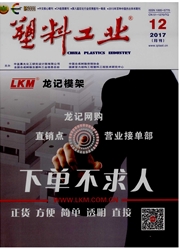

 中文摘要:
中文摘要:
利用实验室自行设计制造的微纳叠层共挤出成型设备,通过串联不同数目的层叠取向模具,分别制备了2层、8层和32层高密度聚乙烯(HDPE)/白色色母和HDPE/蓝色色母微层复合材料以及32层和512层聚丙烯(PP)/尼龙6(PA6)微层复合材料。通过扫描电子显微镜观察研究了多级模内层叠取向模具对高分子复合材料分层和层叠效果。结果表明,多层HDPE/白色色母和HDPE/蓝色色母复合材料层厚均匀且排列整齐,是一种理想的多层板形态;32层PP/PA6复合材料中PP层和PA6层沿挤出方向交替排列,形成了连续的层状结构,但PP层与PA6层之间的界面发生弯曲且界面间隙较大;512层PP/PA6复合材料中,微层厚度急剧减小,接近于微纳米级别,层与层之间的黏结性比层数少的复合材料更好。
 英文摘要:
英文摘要:
2-layer, 8-layer and 32-layer microlayered composites for high-density polyethylene (HDPE)/white masterbatch and HDPE/blue masterbatch, and 32-layer, 512-layer microlayered composites for polypropylene/polyamide6 (PP/PA6) were prepared by micro-layer co-extrusion equipment. The morphology structure of microlayer composites and the laminated effect on composite by multistage laminating orientation die were characterized by SEM. The results suggested that HDPE/white masterbatch and HDPE/ blue masterbatch composites with uniform layer thickness and arrange orderliness were an ideal form of sandwich plate; PP layers and PA6 layers were combined as an ahernatingly multilayered structure along the extrusion direction, but the interface of PP layers and PA6 layers was warped and interface gap was large; Microlayer thickness decreases composite, and the cohesiveness less number of layers. sharply and close to scale of micro-nano meter for 512-layer PP/PA6 between PP layers and PP layers was better than microlayer composites with
 同期刊论文项目
同期刊论文项目
 同项目期刊论文
同项目期刊论文
 Plasticizer migration from micro-layered flexible poly (vinyl chloride)films prepared by multi-layer
Plasticizer migration from micro-layered flexible poly (vinyl chloride)films prepared by multi-layer Study on Transient Heat Transfer of Micro-injection Molded Structures based on the Finite Element Me
Study on Transient Heat Transfer of Micro-injection Molded Structures based on the Finite Element Me 期刊信息
期刊信息
